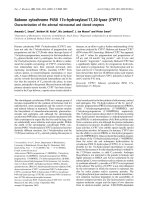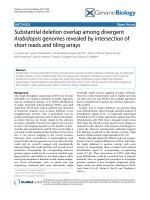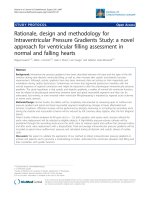Báo cáo y học: "Noninvasive positive pressure ventilation for respiratory failure caused by exacerbations of chronic obstructive pulmonary disease: a standard of care" ppt
Bạn đang xem bản rút gọn của tài liệu. Xem và tải ngay bản đầy đủ của tài liệu tại đây (34.04 KB, 3 trang )
400
COPD = chronic obstructive pulmonary disease; ICU = intensive care unit; NPPV = noninvasive positive pressure ventilation.
Critical Care December 2003 Vol 7 No 6 Hill
In a recent issue of the British Medical Journal, Lightowler
and coworkers [1] presented a meta-analysis of seven
randomized controlled trials of noninvasive positive pressure
ventilation (NPPV) to treat acute respiratory failure caused by
chronic obstructive pulmonary disease (COPD)
exacerbations as compared with ‘usual care’. Their analysis
showed substantial and statistically significant reductions in
mortality (relative risk 0.41), intubation (relative risk 0.42) and
complications (relative risk 0.32). In addition, respiratory rate,
pH, and arterial carbon dioxide tension improved significantly
more after the first hour of treatment, and the duration of
hospital stay was approximately 3 days shorter among NPPV-
treated patients. The authors concluded that ‘NPPV should
be considered early’ to treat respiratory failure due to COPD
exacerbations. In an accompanying editorial, Babu and
Chauhan [2] advocated the ‘timely use of non-invasive
ventilation in more severe exacerbations’. The question is at
what point does the weight of evidence become sufficient to
establish a new standard of care, replacing ‘usual’ care as
applied in the control groups of the randomized trials? My
opinion is that we now have enough evidence to establish a
new standard. The analysis by Lightowler and coworkers did
not include several studies that provide further supportive
evidence [3,4], and other meta-analyses have drawn similar
conclusions [5]. Furthermore, consensus groups of experts
advocate the routine use of NPPV for selected patients with
COPD exacerbations [6,7].
The question must be asked in arguing this position – are
there weaknesses in the evidence base? Lightowler and
coworkers acknowledged that meta-analyses are subject to
publication bias – that favorable trials are more likely to be
published than are unfavorable ones. In addition, all NPPV
trials in the acute setting are limited by the problem that
complete blinding is virtually impossible. Even if a sham
control group were included, which was not the case in any
of the trials, it is quite easy for investigators and patients to
tell which group they are in. Nonetheless, the consistency of
the favorable findings among multiple studies reduces but
does not eliminate concern about these kinds of biases.
Commentary
Noninvasive positive pressure ventilation for respiratory failure
caused by exacerbations of chronic obstructive pulmonary
disease: a standard of care?
Nicholas S Hill
Pulmonary, Critical Care and Sleep Division, TUFTS – New England Medical Center, Boston, MA, USA
Correspondence: Nicholas S Hill,
Published online: 30 May 2003 Critical Care 2003, 7:400-401 (DOI 10.1186/cc2335)
This article is online at />© 2003 BioMed Central Ltd (Print ISSN 1364-8535; Online ISSN 1466-609X)
Abstract
This editorial comments on a meta-analysis of the use of noninvasive positive pressure ventilation to
treat patients with acute respiratory failure caused by chronic obstructive pulmonary disease (COPD)
exacerbations published in the British Medical Journal earlier this year. Based on its analysis of seven
randomized controlled trials that met pre-specified criteria, the meta-analysis demonstrated highly
significant benefits of noninvasive positive pressure ventilation in COPD patients, including a reduction
in a combined end-point consisting of death and endotracheal intubation. The editorial argues that,
based on the strength of this and other evidence, noninvasive positive pressure ventilation to treat
selected patients with acute respiratory failure due to COPD exacerbations should now be considered
a standard of care.
Keywords acute respiratory failure, chronic obstructive pulmonary disease, COPD exacerbation, mechanical
ventilation, noninvasive ventilation
401
Available online />There is wide agreement that patients with COPD
exacerbations who are candidates for noninvasive ventilation
should be selected carefully [6,8]. Selection criteria have not
been validated in prospective trials, but virtually all of the
randomized controlled trials have used similar criteria. In
addition, several studies have identified factors that predict
the likelihood of success, which include the following [9,10]:
a better neurologic score; a lower Acute Physiology and
Chronic Health Evaluation score; less air leaking; a higher
pH; and – the strongest predictor – a significant
improvement in respiratory rate, pH or arterial carbon dioxide
tension within the first hour or two. Based on studies that
showed no benefit in patients with milder exacerbations [11],
the standard recommendation is to select patients with more
severe exacerbations as characterized by moderate-to-severe
dyspnea and evidence of acute or acute-on-chronic gas
exchange disturbances. In addition, patients considered to
be poor candidates for noninvasive ventilation, such as those
who are in respiratory arrest, medically unstable otherwise,
uncooperative, and unable to protect their airway or handle
airway secretions or accommodate a mask, are routinely
excluded. Admittedly, these selection criteria are largely
subjective and, like the decision to intubate, they require that
clinicians exercise judgment.
COPD is often accompanied by comorbidity, and few studies
have examined the effect of comorbid conditions on the
outcomes of COPD patients treated with NPPV. However,
those with concomitant congestive heart failure are likely to
benefit based on studies demonstrating significant benefit of
NPPV in patients with congestive heart failure [8], and a
randomized controlled trial has shown that patients with
COPD exacerbations complicated by community-acquired
pneumonia fare better when treated with NPPV as compared
with conventional therapy [12]. Caution is advised, however,
when using NPPV in patients with COPD exacerbations
suffering from acute myocardial infarction.
Respiratory failure due to COPD exacerbations can occur in
other settings apart from at presentation to the emergency
department or intensive care unit (ICU), for example
postoperatively. In this setting, NPPV can be applied using
the selection criteria described above, except that patients
with upper airway or esophageal surgery should be excluded,
and many surgeons are cautious about applications in
patients who have undergone abdominal surgery requiring
disruption of gastric or small bowel mucosa.
Even when patients are selected according to the above
criteria, a substantial minority of patients will still fail and
require intubation, ranging from 7% to 30% among the
controlled trials [1]. Future studies should shift their focus
from establishing the efficacy of NPPV to the refinement of
selection and application techniques with the aim of
minimizing the failure rate. Potential reasons for failure
include selection of inappropriate candidates for NPPV,
progression of the underlying disease, failure to achieve good
patient–ventilator synchrony, mask intolerance, and lack of
experience or skill on the part of care givers. The
contributions of these factors and ways of addressing them
can be tested in future studies with the ultimate aim of
optimizing the application and utilization of NPPV.
At the present time, NPPV can be considered a standard of
care only for selected patients with COPD exacerbations.
Evidence is not sufficiently strong to support such a view for
other applications of NPPV. For acute pulmonary edema,
evidence clearly indicates that noninvasive positive pressure
techniques are effective at promptly reducing dyspnea,
improving oxygenation, and avoiding intubation [7], but it is
not clear whether NPPV is superior to continuous positive
airway pressure alone. There is also strong evidence to
support the use of NPPV as the modality of first choice in
patients with acute respiratory failure in the face of
immunocompromised status, but these patients still have
poor outcomes even when treated with NPPV [13] and the
need to perform diagnostic procedures sometimes
necessitates intubation. In other forms of respiratory failure, a
trial of NPPV may be reasonable but it is difficult to argue
that NPPV should be considered a standard of care. These
include acute asthma, exacerbations of cystic fibrosis, various
forms of hypoxemic respiratory failure, use of NPPV to
facilitate weaning or to avoid extubation failure in non-COPD
patients, and do-not-intubate patients. Some of these
applications may become standards of care as evidence
accrues from further investigations.
In a survey of NPPV utilization in European ICUs, Carlucci
and coworkers [14] found that 20% of ICUs were not using
NPPV at all. This is concerning because, if the use of NPPV
to treat patients with acute respiratory failure due to COPD
exacerbations is accepted as a standard of care, then this
means that a substantial minority of institutions in Europe,
and undoubtedly in the USA as well, are not offering therapy
that meets current standards. Efforts must be undertaken to
ensure that institutions under-utilizing or not currently using
NPPV acquire the requisite knowledge and skill to offer this
clearly effective therapy to their patients.
Competing interests
NSH has received research grants from ResMed Inc and
Respironics Inc, and is a member of the ResMed medical
advisory board.
References
1. Lightowler JV, Wedjicha JA, Elliott MW, Ram FSF: Non-invasive
positive pressure ventilation to treat respiratory failure result-
ing from exacerbations of chronic obstructive pulmonary
disease: Cochrane systematic review and meta-analysis. BMJ
2003, 326:185-187.
2. Babu KS, Chauhan AJ: Non-invasive ventilation in chronic
obstructive pulmonary disease. Effective in exacerbations
with hypercapnic respiratory failure. BMJ 2003, 326:177-178.
3. Bott J, Carroll MP, Conway JH, Keilty SE, Ward EM, Brown AM,
402
Critical Care December 2003 Vol 7 No 6 Hill
Paul EA, Elliott MW, Godfrey RC, Wedzicha JA, et al.: Random-
ized controlled trial of nasal ventilation in acute ventilatory
failure due to chronic obstructive airways disease. Lancet
1993, 341:1555-1557.
4. Kramer N, Meyer TJ, Meharg J, Cece RD, Hill NS: Randomized,
prospective trial of noninvasive positive pressure ventilation
in acute respiratory failure. Am J Respir Crit Care Med 1995,
151:1799-1806.
5. Peter JV, Moran JL, Phillips-Hughes J, Warn D: Noninvasive ven-
tilation in acute respiratory failure-a meta-analysis update.
Crit Care Med 2002, 30:555-562.
6. Bach JR, Brougher P, Hess DR, Hill NS, McIntyre N, Pearson D,
Rubenfeld G: Consensus statement: noninvasive positive pres-
sure ventilation. Respir Care 1997, 42:365-369.
7. British Thoracic Society Standards of Care: Non-invasive venti-
lation in acute respiratory failure. Thorax 2002, 57:192-211.
8. Mehta S, Hill NS: Noninvasive ventilation. Am J Respir Crit Care
Med 2001, 163:540-577.
9. Ambrosino N, Foglio K, Rubini F, Clini E, Nava S, Vitacca M: Non-
invasive mechanical ventilation in acute respiratory failure
due to chronic obstructive pulmonary disease: correlates for
success. Thorax 1995, 50:755-757.
10. Soo Hoo GW, Santiago S, Williams J: Nasal mechanical ventila-
tion for hypercapnic respiratory failure in chronic obstructive
pulmonary disease: determinants of success and failure. Crit
Care Med 1994, 27:417-434.
11. Barbe F, Togores B, Rubi M, Pons S, Maimo A, Agusti AGN: Non-
invasive ventilatory support does not facilitate recovery from
acute respiratory failure in chronic obstructive pulmonary
disease. Eur Respir 1996, 9:1240-1245.
12. Confalonieri M, Potena A, Carbone G, Della Porta R, Tolley EA,
Meduri GU: Acute respiratory failure in patients with severe
community-acquired pneumonia. Am J Respir Crit Care Med
1999, 160:1585-1591.
13. Hilbert G, Gruson D, Vargas F, Valentino R, Gbikpi-Benissan G,
Dupon M, Reiffers J, Cardinaud JP: Noninvasive ventilation in
immunosuppressed patients with pulmonary infiltrates, and
acute respiratory failure. N Engl J Med 2001, 344:481-487.
14. Carlucci A, Richard J-C, Wysocki M, Lepage E, Brochard L: Non-
invasive versus conventional mechanical ventilation: and epi-
demiological survey. Am J Respir Crit Care Med 2001, 163:
874-880.









